17 min read
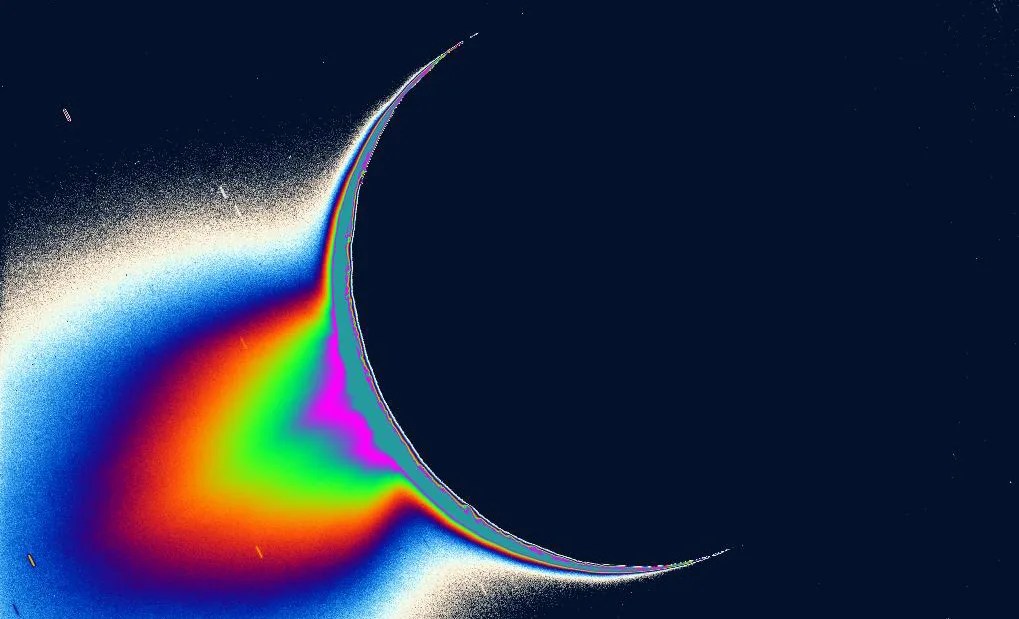
Before NASA’s Cassini mission, Saturn's moon Enceladus was thought to be like many of the countless objects in our solar system –cold, small, and well outside the habitable zone – yet scientists still thought it worthy of a closer look.
“The first observations of Enceladus showed it as a tiny white dot, brighter but not unlike other moons of Saturn,” said Linda Spilker, the Cassini mission’s project scientist. “It was so small we never thought it might be a prime astrobiology target.”
Starting in 2005, Cassini’s discoveries elevated the small, icy moon to its rightful place alongside Mars and Jupiter's moon Europa – thought to be the best places beyond Earth to search for conditions suitable for past or present life. Because of Cassini, Enceladus is now one of the most consequential objects in the solar system.
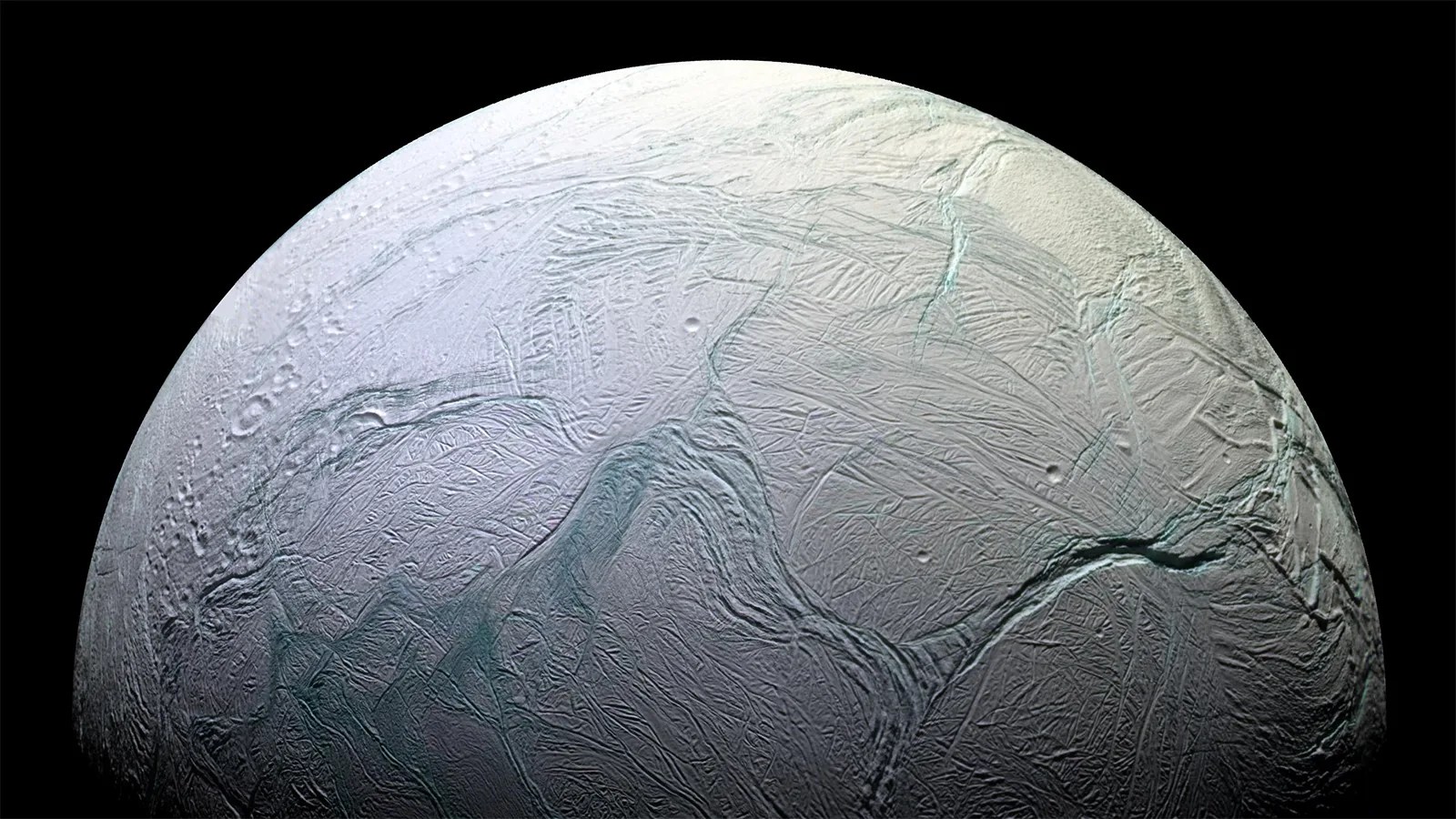
All things considered, it would be reasonable to expect any solid world as small and far from the Sun as Enceladus, with no atmosphere to insulate it, to be frigid and inactive.
Sunlight is so faint at the Saturn system that Enceladus is truly out in the cold. Since Saturn is nearly 10 times farther from the Sun than Earth, objects in the Saturn system receive barely one-hundredth the sunlight that Earth does.
Enceladus’ size doesn’t help it stay warm either. At just a hair over 300 miles (500 kilometers) in diameter, Enceladus could fit comfortably between San Francisco and Los Angeles. And smaller worlds have a harder time retaining heat because they have more surface area per volume than larger worlds. So even if it had once been a warm world, Enceladus wouldn’t have stayed warm for long. “For a moon that size, we expected it to be frozen solid,” Spilker said.
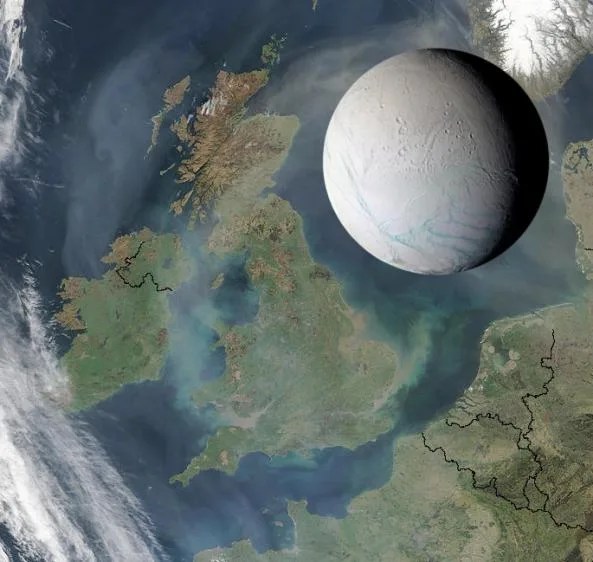
Until Cassini, most knowledge about the Saturn system had come from the Voyager flybys in 1981 and 1982. Voyager project scientist, and co-investigator on Cassini’s Composite Infrared Spectrometer (CIRS), Spilker began her study of the Saturn system while working with IRIS, an infrared instrument on the Voyager mission, which didn’t have the best opportunity to investigate Enceladus. “What was interesting about the Voyager flybys is that Enceladus’ south pole was in darkness,” Spilker said. And the closest Voyager flyby was about 56,000 miles (90,000 kilometers) from the tiny moon. “Oh, what a big surprise was waiting for Cassini.”
That’s not to say scientists knew nothing about Enceladus.
“We did know that it was one of the whitest and brightest objects in the solar system,” said Morgan Cable, a research scientist studying ocean worlds at NASA’s Jet Propulsion Laboratory. Enceladus is, in fact, the whitest. It reflects nearly 100% of the sunlight that strikes it. (Earth’s Moon reflects only about 11% of the sunlight that hits it). “We knew the surface was nearly pure, pristine water ice,” Cable said. “It’s the only thing that can be that reflective, which also suggested that the surface was young.”
“And we knew that Enceladus was in and around the E ring of Saturn,” Cable said. “So there were theories about how those two were linked – whether Enceladus was forming out of the E ring or it’s slowly disintegrating or otherwise feeding the E ring.”
Scientists wondered if Enceladus might have ice volcanoes, or if meteor impacts knocked bits of its surface off into space to contribute to the E ring. But they didn’t know.
“Enceladus was interesting,” Cable said. “But no one knew just how interesting until Cassini got there.”

Cassini blasted off from Earth in October 1997 and entered Saturn's orbit in 2004. It didn’t take long for Enceladus to start dishing out surprises.
Cassini began studying Enceladus in February 2005 when the spacecraft passed within 725 miles (1,167 kilometers) of the moon. The spacecraft’s magnetometer (MAG) detected a localized bending of Saturn’s magnetic field in the space above Enceladus, almost like it had an atmosphere.
“The magnetic field lines were standing off from Enceladus’ surface, more like you’d see with a comet, but just at the south pole,” Spilker said. At the same time, the spacecraft’s Cosmic Dust Analyzer (CDA) detected thousands of dust-sized particles. Cassini's cameras also spied linear features near the south pole that had a different color than the rest of the icy surface, suggesting they might be relatively young.
When Cassini flew by Enceladus a second time the following month, the magnetometer again detected the bending effect, as well as an oscillation in the magnetic field. Particles called ions – atoms or molecules with an electric charge – whirl in spirals around magnetic field lines, making the magnetic field seem to oscillate. The frequency of the oscillation tells scientists what kind of ionized molecule or atom was responsible. In this case, the oscillation suggested ionized water particles.
Cassini’s next Enceladus flyby, in July 2005, was supposed to put the spacecraft within 625 miles (1,000 kilometers) of the moon's surface. But the magnetometer observations had intrigued scientists, to put it mildly. They wanted a closer look. Like 500 miles closer.
The mission's navigators adjusted Cassini's flight path so that the probe skimmed past Enceladus on July 14, at just 109 miles (175 kilometers) above the moon’s surface – closer than any spacecraft had ever gone.
Scientists knew from Voyager that the surface had relatively few craters, but Cassini found that around the south pole, Enceladus’ surface was nearly free of craters. “That was important because impact craters are a great way to tell us how old things are,” Cable said. “The more craters, the older something usually is. The fewer craters, the younger it usually is.”
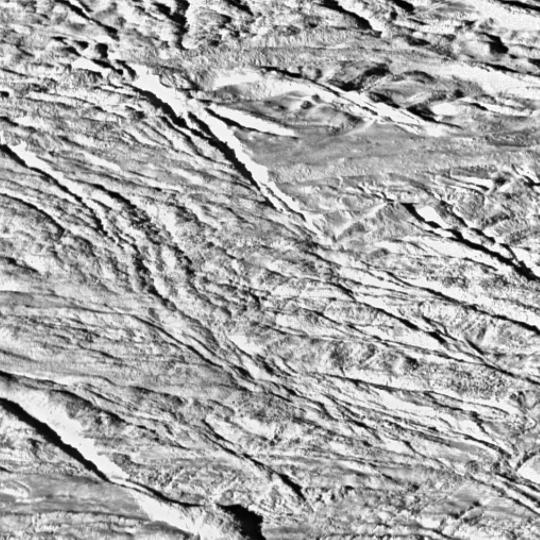
Space rocks had presumably hit Enceladus in the past – almost all of Saturn’s moons are heavily cratered. “But at Enceladus, things have come along and erased them, whether it’s something melting and filling in craters or it’s something that then covers up those craters,” Cable said. “So Enceladus’ surface is very young.”
Cassini’s imaging cameras also captured views of countless ice boulders the size of houses sitting on the surface, apparently placed there by activity in the moon's icy shell. Faults and ridges crisscrossed the icescape. Everything seemed to indicate that the south polar region had the freshest surface on Enceladus.
Cassini scientists also found what appeared to be a surprisingly dense cloud of water vapor and ice grains over the south pole, and the flyby helped scientists confirm earlier suspicions that Enceladus is the main source of material for Saturn’s E ring. But the temperatures they saw were the real game-changer.
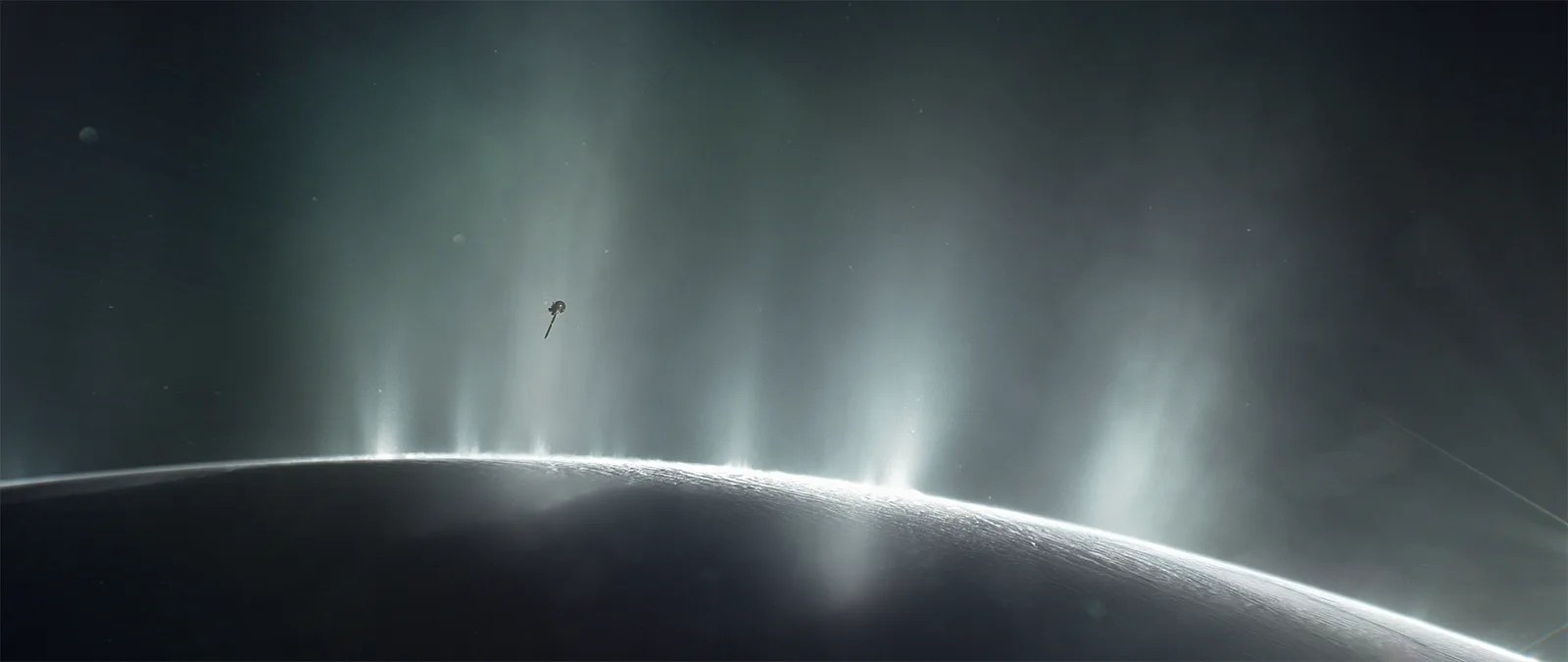
At its equator, which receives the most direct sunlight, surface temperatures on Enceladus average minus 316 degrees Fahrenheit (minus 193 Celsius). The south pole should be even colder since it receives less sunlight. Instead, the average temperature there was slightly warmer than the equator, at minus 307 Fahrenheit (minus 188 Celsius). And the linear fractures there, now referred to as the "tiger stripes," were as warm as minus 261 Fahrenheit (minus 163 Celsius) in some places. That’s 70 degrees warmer than the equator. Clearly, Enceladus was no dead world. It was active.
Scientists thought that the water cloud above Enceladus might be produced by water evaporating from the fissures via a surface process similar to what happens on a comet. But instead of sunlight, which provides the heat for evaporation from comets, the heat source that might power the evaporation at Enceladus was unknown. Maybe tidal friction or radioactivity instead of sunlight was providing the heat needed to convert water ice to a gas. Regardless, the comet idea wouldn’t last.
By March 2006, images from the spacecraft showed far too much material coming off the moon, and far too fast. Cassini scientists ruled out the comet concept.
Scientists found that water was not transitioning at the surface directly from warm ice into a gas. It appeared more likely that Enceladus was somehow warm enough to allow small reservoirs of liquid water to collect a few dozen feet below the moon’s surface. The water could shoot up through cracks and spray out like geysers, creating what was now being called a “plume” above the moon’s south pole.
But liquid water near the surface would be an extraordinary find. A moon so small and so far from the sun had no business harboring liquid water.
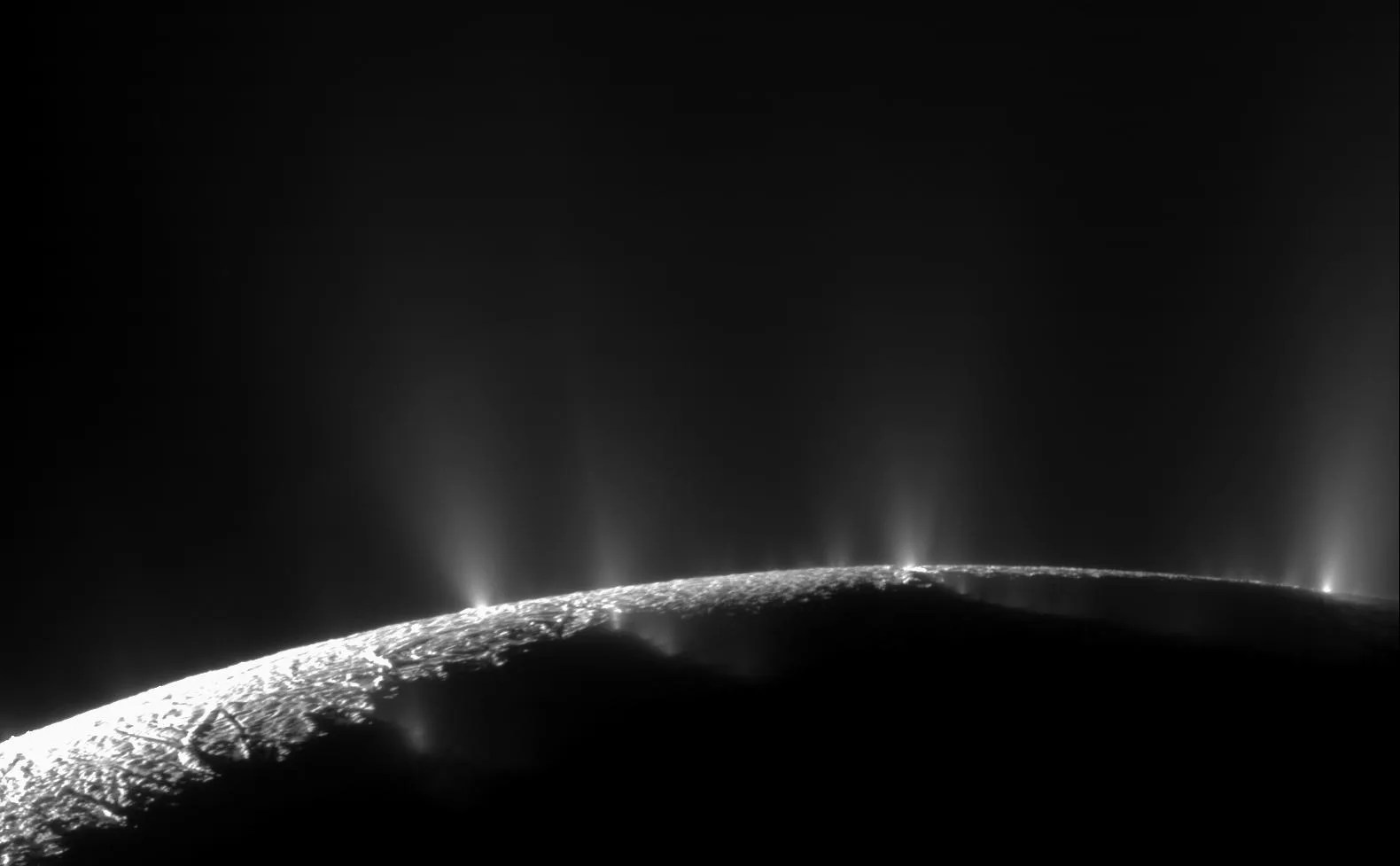
The near-surface reservoirs idea was a “best guess,” but was by no means conclusive, and scientists couldn’t make more close observations of Enceladus for a while. As planned, Cassini’s orbit was changing, and wouldn’t carry the spacecraft near Enceladus again until 2008.
But Cassini scientists now had three flybys-worth of data to comb through in detail. So the mission’s imaging team analyzed two years of images and compared them to surface temperature data from the spacecraft’s infrared spectrometer. The scientists used images of Enceladus taken when Cassini was in different positions around the moon to narrow down the jets’ locations.
In October 2007 they announced that essentially all of the jets come from the four tiger stripe fractures, and that nearly all of them come from places the infrared spectrometer measured as the warmest.
Only one more Enceladus flyby remained in the four-year primary mission.
Then, in April 2008, NASA extended the Cassini mission by two years, with Enceladus now ranked as one of the highest-priority targets. NASA later extended the mission a second time, out to 2017. In all, the extensions gave scientists a total of 23 targeted Enceladus flybys, instead of the original four.
With that, the pages of Enceladus’ story began to pile up adventurously.
In March 2008, Cassini performed a flyby to study material coming out of the jets. The spacecraft flew directly through the plume at an altitude of 120 miles (200 kilometers).
Instrument data allowed Cassini scientists to determine that water and other material were jetting out of the moon’s surface at about 800 miles (1,300 kilometers) per hour. The Ion and Neutral Mass Spectrometer (INMS) analyzed particles and gases in the plume, which contained water vapor, along with carbon dioxide, carbon monoxide, and organic materials, all at much higher densities than scientists expected.
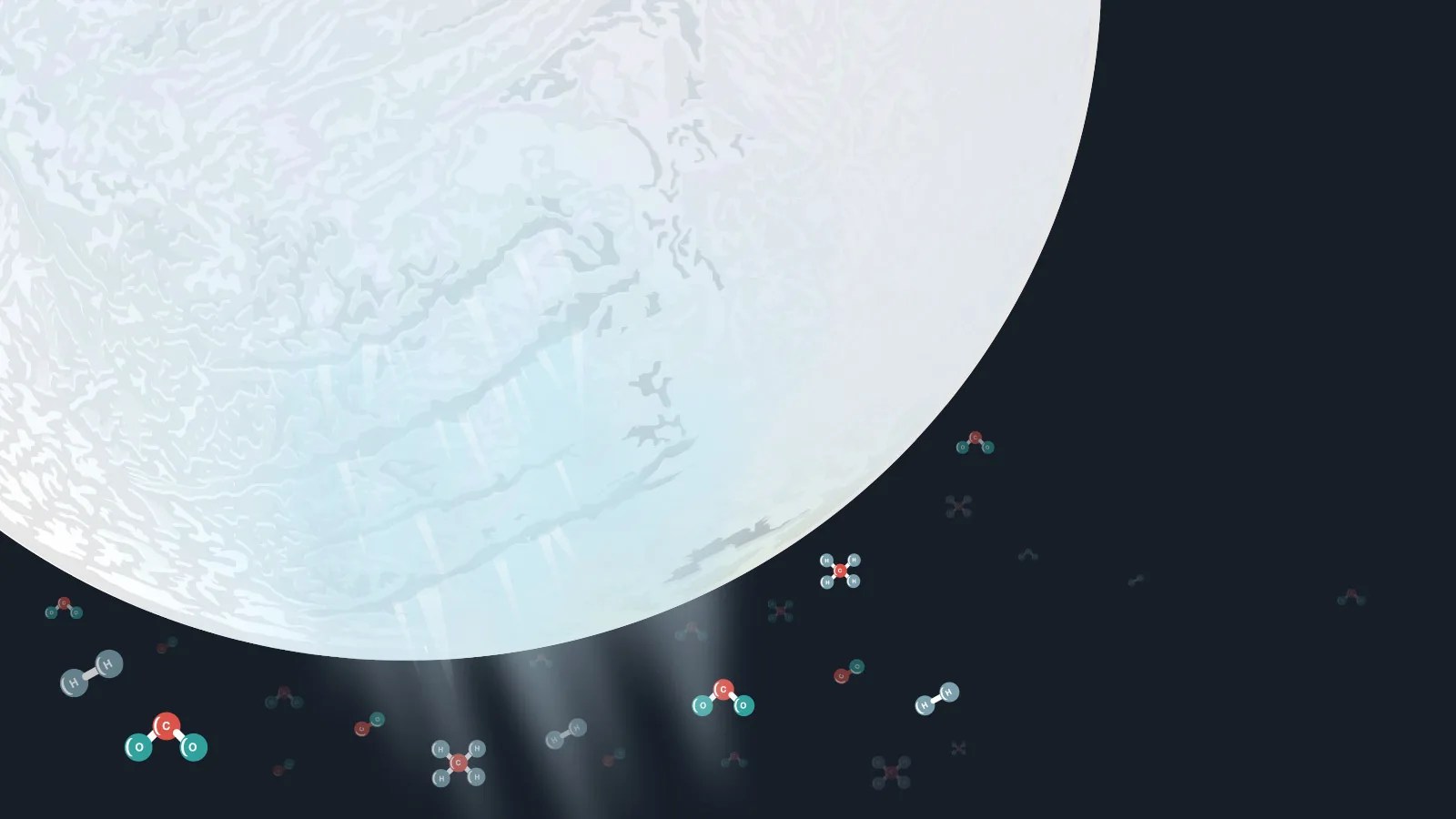
During the flyby, the CIRS instrument created new, high-resolution heat maps of the south pole and found the tiger stripe fissures are, almost from end to end, warmer than the surrounding surface. The spectrometer found that in places, the surface temperature was minus 135 degrees Fahrenheit (minus 93 Celsius), even warmer than previously measured.
Just a few months later, in August, Cassini flew close by Enceladus at 40,000 miles per hour (64,000 kilometers per hour) and quickly snapped shots of the moon’s surface to pinpoint where the jets originate along the tiger stripes. The camera even allowed scientists to measure the inner shape of the fractures, which appear to be about 980 feet (300 meters) deep with V-shaped inner walls.
Over the next three years or so, researchers began putting more pieces together through further flybys of the tiny moon and by synthesizing observations they’d made in previous flybys.
In June 2009, scientists working with Cassini’s Cosmic Dust Analyzer announced they’d found salt in the ice grains whirling about in Saturn’s E ring, the vast outer ring produced by material now known to be jetting out of Enceladus.
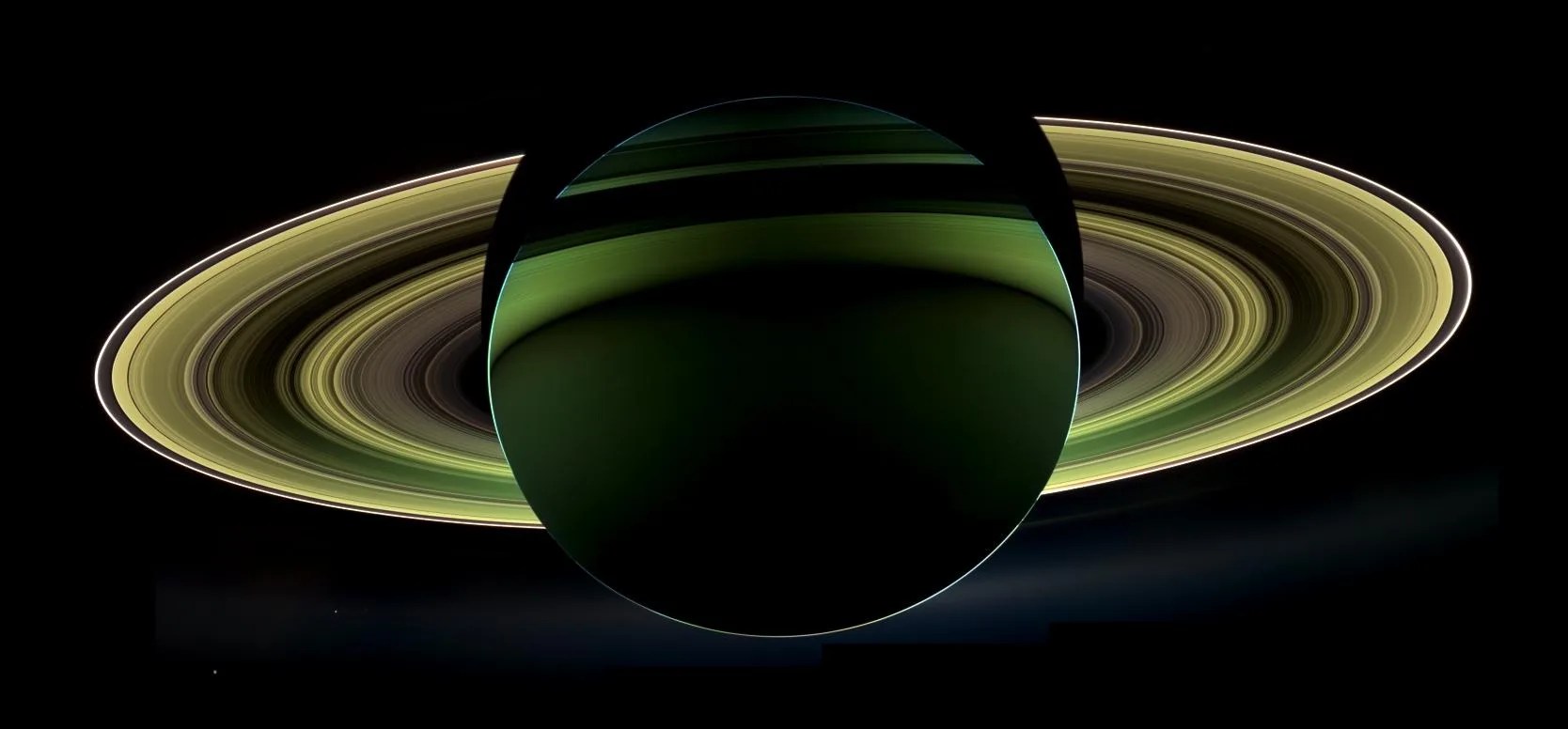
Nothing except liquid water could dissolve enough material to make the ice particles so salty. Also, if the plume were being produced by water vaporizing, it wouldn’t be able to carry the salt with it, according to Spilker. “To get salt particles lofted, you actually need tiny droplets of water to carry the salt. If you just took water that went from a liquid to a vapor, it would leave the salt behind.”
The salt would then build up on the surface as it does in salt flats. “So to get those sodium and potassium particles into the plume, you had to have spray that would freeze and come up out of the jets,” Spilker said. “You needed, at least under the south pole, liquid water.”
The discussion about Enceladus was now shifting from subsurface water reservoirs to maybe a subsurface saltwater ocean.
The next month, scientists using Cassini’s INMS instrument to study Enceladus’ plume reported they’d found definitive evidence of ammonia, which was further evidence of liquid water.
A November 2009 flyby provided the Cassini team with the best ever 3-dimensional image of a tiger stripe, as well as the discovery of new water jets and changes in activity among some known jets.
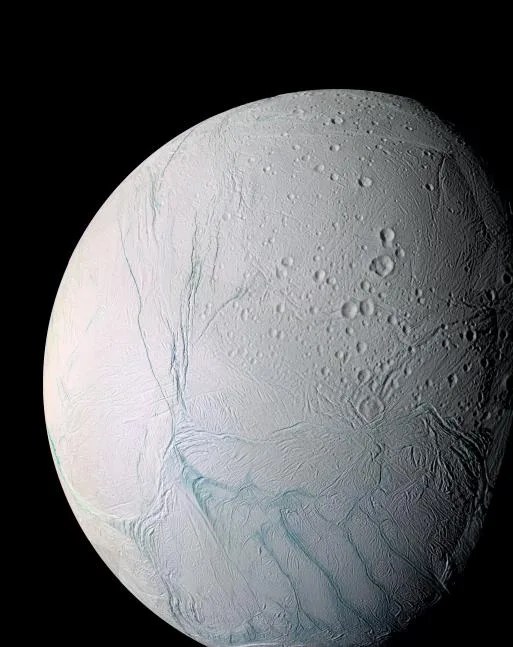
Then a new puzzle presented itself in October 2010. Cassini scientists had calculated how Enceladus’ orbit of Saturn would produce tidal stress in the little moon’s crust. But when they mapped the places where Enceladus should experience the most stress and compared them to warm zones mapped out by the infrared spectrometer instrument, the two didn’t line up. Researchers thought the discrepancy could be explained, but only if the moon wobbles as it spins – a strange prospect.
In June 2011, scientists realized that not only does Enceladus gush water into Saturn’s E ring, it also produces a huge, extended torus – a doughnut shape – of its ejected material around Saturn. The European Space Agency’s Herschel Space Observatory discovered the ice-particle doughnut, a small fraction of which eventually falls into Saturn’s upper atmosphere.
Saturn has water clouds of its own, but the water can’t reach as high in the planet's atmosphere as the water Enceladus sprinkles in, which makes icy little Enceladus the only moon in the solar system known to influence the chemistry of its parent planet.
Through 2012 and 2013, Cassini scientists increasingly found a relationship between gravitational stress and changes in Enceladus’ jets. Like all planets and moons in the solar system, Enceladus doesn’t orbit in a perfect circle. Its path is instead elliptical, and the gravitational stress of being sometimes closer to and sometimes farther from Saturn causes the fractures in the tiger stripes to open and close as the moon travels around its planet.
At this point, at least some scientists were seriously considering that Enceladus may have a regional ocean, or even a global one, partly because the icy shell covering Enceladus would need an ocean below for its ice shell to flex as much as it does. Gravitational experiments soon reinforced that notion.
Cassini radio scientists announced in April 2014 that during three Enceladus flybys from 2010 to 2012, they’d observed a Doppler shift in radio signals from Cassini that were consistent with Enceladus hosting an ocean about 6 miles (10 kilometers) deep below an ice shell 19 to 25 miles (30 to 40 kilometers) thick.
Then, in July 2014, Cassini scientists reported that, after analyzing years of image data from the CIRS instrument, as well as recent observations from Cassini’s Visual and Infrared Mapping Spectrometer (VIMS), they had determined the “hotspots” around the geysers or jets on Enceladus were hyper-local. High-resolution images indicated that the hotspots were only a few dozen feet (tens of meters) across and centered around each jet. If the jets were powered by heat produced from tidal friction in the moon’s icy shell, the hotspots would be larger.
This meant that, rather than being the cause of the jets, the hotspots were the result of the jets. Warm liquid water was traveling up through cracks and depositing some of its heat in the surface ice as the water sprayed into space. Scientists concluded that a subsurface ocean was the only possible source for the water in the jets. An ocean was simply the only scenario that made sense, given the data from Cassini.
Then, a remarkable idea began taking root in early 2015. Evidence indicated that Enceladus might have hydrothermal activity, which would make it the only place beyond Earth where such conditions have been shown to exist. It could also mean that Enceladus was more habitable than previously thought.
It works like this: Seawater seeps deep into the seafloor where the water gets heated and reacts with minerals in the rocky crust. When the water emerges from the seafloor, it carries dissolved minerals up with it and, on Earth at least, serves as the foundation for a rich ecosystem.
At Enceladus, scientists think that hot water containing dissolved silica gushes up into the cooler water of the subsurface ocean. The silica cools quickly in the cold water, forming crystals that are carried upward and eventually out through cracks in the crust and into space. The scientists reached this conclusion after analyzing years of data from Cassini’s Cosmic Dust Analyzer, which had repeatedly detected tiny particles rich in silica.
Separately, a team of scientists was trying to figure out why the plume of Enceladus is so rich in methane, and concluded that hydrothermal activity was one of the most likely explanations.
Enceladus’ story got weirder in the autumn of 2015. For a moon so small and far from the Sun to have a subsurface liquid water ocean was remarkable, but Cassini scientists had warmed up to the idea. The ocean was thought to be lens-shaped and fairly big. Gravity measurements from some of Cassini’s close flybys near the south polar region had hinted that the ocean could be global, but scientists had little other evidence to think that was the case. That changed with a paper published that September.
Researchers had been meticulously mapping the positions of features on Enceladus’ surface using hundreds of photos from more than seven years of Cassini's mission. They tracked craters so they could precisely measure how the moon spins on its axis and found that Enceladus wobbles as it goes.
Enceladus is tidally locked to Saturn, meaning that the same side of the moon always faces the planet. This means the moon spins on its axis at the same rate it orbits Saturn. The wobble, or libration, is a left-to-right motion. It’s subtle, like a baseball pitcher’s head indicating “no” to the catcher behind home plate when choosing a pitch.
“The amount of libration tells you if it’s a solid body or if the crust is floating on an ocean like a lubricant,” Spilker said. It was a small wobble for Enceladus, but a giant realization for Cassini scientists.
Based on the wobble, researchers created models of how Enceladus could be put together on the inside. The only model that fit was if a liquid layer completely separated the porous rocky core from the icy shell. Enceladus simply couldn’t wobble so much if the shell and the core were solidly connected. The pieces fit. Enceladus had a global ocean.
“It makes Enceladus a lot more interesting to me,” said Steve Vance, an astrobiologist studying ocean worlds at JPL. Vance is a staff scientist for NASA's upcoming Europa Clipper mission to Europa, one of Jupiter’s largest moons that, like Enceladus, is thought to have a global subsurface ocean of liquid water. “A global ocean makes Enceladus more Europa-like. It makes it more Earth-like,” Vance said.
If limited to the south polar region of Enceladus, the moon’s ocean could be temporary, perhaps the result of a meteor strike. “That it’s global means that it’s stable and a long-lived environment,” Vance said.
And a long-lived environment would give life more time to secure a foothold.
Over the course of the mission, instruments detected in Enceladus’ plume organic and nitrogen-bearing molecules such as acetylene, ammonia, carbon dioxide, and methane. And silica grains in the plume are of a size that likely formed in the kind of hydrothermal vents that, on Earth, are the foundation of rich ecosystems.
In June 2023, using data collected by the Cassini mission, an international team of scientists discovered phosphorus – an essential chemical element for life – locked inside salt-rich ice grains ejected into space from Enceladus.
Spilker characterizes the triumph of Enceladus as a great detective story. “It took all of the instruments on Cassini to put together the puzzle and help us learn what we know about Enceladus today. It took the whole team working together.”
Cassini’s discoveries at Enceladus spawned a new way of considering possible “habitable zones” for those seeking extraterrestrial life, Spilker said. “It’s really expanded our horizons, completely changed our thinking, and revolutionized our view of where you could find life in the solar system and beyond. It's an Ocean World.”







